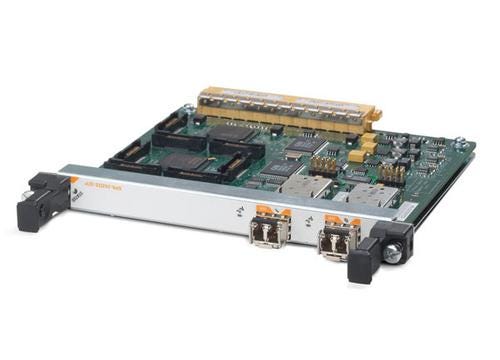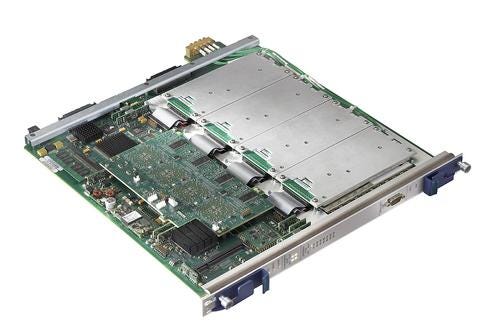New downstream CMTS modules are reducing port prices by 50% or more, speeding development of 100-Mbit/s services based on Docsis 3.0

Timing is everything.
Just as cable operators prepare to test and launch Internet services with speedier downstream capabilities, the top three providers of cable modem termination system (CMTS) gear -- Cisco Systems Inc. (Nasdaq: CSCO), Arris Group Inc. (Nasdaq: ARRS), and Motorola Inc. (NYSE: MOT) -- have developed, or are in the process of developing, new downstream-heavy modules that snap into their widely deployed CMTS chassis. Along with denser downstream footprints, these new cards are also having a profound effect on CMTS pricing.
CMTS downstream port prices are "dropping like a rock," says Patti Reali, an analyst with Gartner Inc. In the early going, much of that trend, she notes, is being driven by Cisco and its development of a special module/linecard. That card, dubbed the Shared Port Adapter (SPA), fits into Cisco's flagship CMTS, the uBR10012.
But the story doesn't start and end with Cisco. Although the CMTS market leader can already point to trials and deployments for its downstream-heavy module, Motorola is gathering steam with its entry, the TX32. Meanwhile, Arris, which is making a run at increased CMTS market share, tells Cable Digital News that it has a new, specialized CMTS card in the making.
While the minimum configuration for Docsis 3.0 calls for the bonding of at least four upstream and four downstream channels, most operators are expected to begin their migration to 3.0-based services by bonding downstream channels. That has as much less to do with competitive pressures than it does with the present state of Docsis 3.0 CMTS technology.
Earlier this month, CMTSs from Arris and Cisco came away with "Bronze" qualification following the first-ever Docsis 3.0 Certification Wave at CableLabs . Casa Systems Inc. , a startup based in Andover, Mass., was the first vendor (and only, so far) to obtain the "Silver" stamp. (See Cisco, Arris & Casa Make the CableLabs Grade.)
Under a tiered CMTS plan introduced in April, the key features of Bronze include downstream channel bonding and IPv6 support. Silver adds in upstream channel bonding and the Advanced Encryption System. To date, no CMTS maker has obtained "Full" Docsis 3.0 qualification. (See CableLabs Accelerates Docsis 3.0 Testing .)
Operators likely will tap into that additional (and cheaper) downstream pool in different ways. Some, particularly those in Asia and Europe, will use it for channel bonding to produce services that ratchet up downstream speeds in the range of 30 Mbit/s to 100 Mbit/s. Others could use it to push the envelope with Docsis 2.0, and offer higher-level base tiers in the neighborhood of 10 Mbit/s to 15 Mbit/s.
Cisco goes to the SPA
Although Cisco has different types of SPA products based on a common footprint, the one that matters in the case of denser downstream capabilities and channel bonding is its Wideband SPA.
One Wideband SPA can support 24 downstreams. That compares to five downstreams (and 20 upstreams) in a traditional Cisco CMTS linecard. 
Cards with denser downstreams are causing downstream port prices to drop significantly.
While $10,000 per downstream has been "a fairly competitive number for the past few years," the new architecture will cut that down to about $5,000, estimates John Mattson, Cisco's senior director of CMTS products.
"But that's just the first step," he adds.
Port costs will be further reduced when one uBR10012 hooks in two Wideband SPAs, enough for 48 downstreams. Later next year, one uBR10012 chassis will be able to accommodate as many as six Wideband SPAs, Mattson says.
For now, most of the Cisco SPA action is occurring outside the U.S., with operators such as Numericable-SFR of France and Hanaro Telecom Inc. of Korea. Vidéotron Telecom Ltd. of Canada, meanwhile, is using Cisco's SPA tech for a 100-Mbit/s market trial. (See Numericable Upgrades, Hanaro Picks Cisco, and Videotron Plans 100-Mbit/s Service.)
"In Europe and Asia, these things are selling like hotcakes, because this is where the competitive dynamic is over-the-top," Mattson says. "In the U.S., there's a lot of activity in planning and trials, but 2008 is viewed by us… as a big year for deployment of this stuff."
Predictably, U.S. markets being penetrated by the Verizon Communications Inc. (NYSE: VZ) FiOS platform "are at the forefront of that [activity]," Mattson notes. "But the U.S. guys like it [the SPA approach] because it's been proven. It's not like it's a science experiment that they have to tolerate."
To Page 2
Motorola's TX32
Unlike Cisco, Motorola did not supply a CMTS for the first Docsis 3.0 test wave, but, like its CMTS competitor, the company is making progress with a new module for its flagship CMTS, the BSR64000, that aims to beef up the downstream and shrink costs on a per-port basis.
Introduced in June, the company' TX32, as the name implies, supports 32 downstreams. That compares to just two downstreams (and eight upstreams) in a traditional linecard for the BSR64000. Much of the tech development behind the TX32 can be traced to Motorola's acquisition in early 2006 of Broadband Innovations, a startup that made high-density, low-power Docsis 3.0-compliant upconverters. (See Moto Deals Downstream Module and Moto Buys RF Tech.) 
The denser downstream footprint will cause port costs to fall by at least 60 percent, according to Mike Cookish, director of product management for the access network solution division of Motorola's Home and Network Mobility business. He puts the cost of today's traditional downstream ports in range of $12,000 to $13,000 each.
"At that price, if they [cable operators] have to triple their downstream, their capital outlay would be huge," Cookish says. He estimates that downstream port prices, with the TX32 in place, could dip to about $4,000 to $5,000 each by the first half of 2008.
As designed, the TX32 removes the upstream, and uses block upconversion techniques to cram 32 downstreams in the same space as its typical 2x8 linecard. In the block upconversion scenario, operators will be required to free up a contiguous slice of spectrum. This means that channels used for downstream bonding must be physically next to each other along the spectrum.
Although this could be considered a drawback because operators don't necessarily have that much free spectrum bunched together, the saving grace is that Docsis 3.0 modems can tune above the 860 MHz threshold. Those devices, therefore, could use 6 MHz channels that are produced from an upgrade to 1 GHz or more. (See Cox Makes 1 GHz Moves .)
Almost all (95 percent) of the HFC (hybrid fiber/coax) infrastructure components that Motorola spec'd out during 2007 were nodes and amplifiers of the 1 GHz variety, according to Floyd Wagoner, Motorola's senior manager of product marketing.
While that doesn't necessarily mean that the plant itself is being turned up to 1 GHz, those equipment orders mark "the beginning of that transition period," he says.
According to Motorola, the TX32 presently is in trials with Tier 1 operators in North America, Europe, Asia, and Latin America. Operators, particularly in Asia, "are screaming for greater downstream bandwidth," Cookish says.
Motorola has not announced any TX32 customers, but one of the most likely candidates is StarHub in Singapore, which has already launched a 100-Mbit/s (down), pre-Docsis 3.0 tier called MaxOnline Premium across the board, based on Motorola CMTSs and modems. Two other possibilities are C&M and CJ CableNet of South Korea, which recently moved ahead with a downstream channel bonding deployment with Motorola. (See Moto Bonds With Korea .)
"I think 2008 is going to be a big year for additional downstream bandwidth, especially if switched digital video takes hold and it frees up capacity," says Cookish, noting that about 15 cable operators around the world are testing the channel bonding concept with Motorola.
Arris getting down with denser downstreams
Arris, meanwhile, is answering the call with a higher-density card that packs in 16 downstreams. That card, which hasn't yet been announced formally, is in the "early trail stages," according to Stan Brovant, Arris's senior vice president of business development and marketing.
Arris has not pinpointed a commercial launch date for the new linecard, but the module was an "ingredient" of the CMTS the vendor supplied to CableLabs for the recently completed Docsis 3.0 Wave, Brovant says.
Brovant declined to assign a specific dollar amount to the effect the new card will have on downstream port pricing, other than to say it would be "substantially cheaper" than what's offered by the legacy cards found in the C4 CMTS, which are configured for 12 upstreams and two downstreams. Those cards can be repurposed as upstream receivers for the emerging modular CMTS (M-CMTS) architecture.
"The installed base is very important. We want to make sure the C4 is upgradeable to Docsis 3.0," Brovant says.
"The interest in higher density and channel bonding is worldwide," he adds. While Verizon's new symmetrical 20 Mbit/s has gained the attention of U.S.-based operators, MSOs abroad are trying to match the speeds offered by networks fed by both fiber-to-the-home and VDSL technologies. (See Verizon Offers 20 Mbit/s Uploads.)
On the pre-Docsis 3.0 channel bonding front, Arris has scored some early wins with Virgin Media Inc. (Nasdaq: VMED) and Japan-based Jupiter Telecommunications Co. Ltd. (J:COM) . (See Arris, NTL Try 100 Mbit/s and Japanese MSO Moves 160 Mbit/s.)
The path to the M-CMTS
Despite the early traction expected from this new breed of downstream-heavy modules for legacy CMTS chassis, their development marks just a step along the path toward a more advanced M-CMTS architecture.
Under that scenario, several components of the traditional CMTS -- including downstream and upstream -- will be separated out so they can be scaled independently and, as the theory goes, more cost-effectively.
While the "core" CMTS will handle the upstream, a new breed of edge QAM devices will supply the downstream capacity. Those "universal" edge QAMs are also being designed so they can share capacity and resources with other applications, including digital broadcast video, video-on-demand (VOD), and switched digital video (SDV). (See Universal Edge QAM Market Heats Up.)
"Operators are taking a pretty sophisticated approach and identifying which architecture makes the most sense," Brovant says. Arris customers that have underutilized C4 CMTSs have been among those most interested in the company's new 16-downstream linecard, he adds.
"There isn't a clear economic advantage to either one," Brovant explains of the different CMTS architectural approaches. "It depends on where the operator is starting from, and what they are trying to achieve."
— Jeff Baumgartner, Site Editor, Cable Digital News
About the Author(s)
You May Also Like











